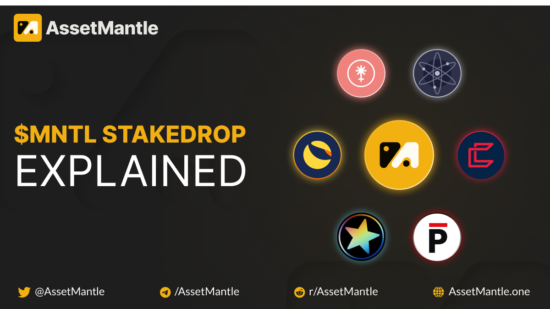TL;DR
StakeDrop is a token distribution mechanism that allows token holders of some of the most prominent Proof-of-Stake networks to get exposure to $MNTL tokens (AssetMantle tokens). It’s designed to have near-zero principal risk.

AssetMantle will be running StakeDrop campaigns on 6 Proof-of-Stake networks as mentioned below.
Token holders of these networks can stake their native assets with any active validator to earn $MNTL tokens, in addition to the current network staking rewards they’re earning (block rewards and/or transaction fees).
The StakeDrop campaign and mechanism were first introduced by Persistence. AssetMantle being a part of the larger ecosystem and the same core team having migrated here enforce a similar methodology following the success of the $XPRT StakeDrop campaign.
Each participating wallet can earn up to a maximum of 5,000 $MNTL tokens. The cap is based on a few parameters that will be discussed in this document.
Partner Networks
- Cosmos Network
- AssetMantle
- Terra
- Comdex
- Juno
- Stargaze
Learn more about the schedule here.
Token and Distribution Details
AssetMantle has allocated 3% of its total supply (9,000,000 $MNTL) at genesis for the StakeDrop. These tokens will be distributed over a period of 12 months following the token generation event. All tokens earned via StakeDrop have a six-month lockup period and will be linearly vested over the next six months.
Read more about the role of $MNTL in the AssetMantle ecosystem here.
Benefits of the StakeDrop
The AssetMantle StakeDrop is designed in such a way that it benefits all stakeholders involved.
The following are the three key stakeholders:
- AssetMantle
- Delegators or StakeDrop Participants
- Partner Networks
AssetMantle
The StakeDrop is a highly targeted method of airdrop, allowing the Mantle team to distribute our tokens to the staking community. These stakers are long-term token holders, not merely speculators.
The core role of the $MNTL token is to secure the network.
The StakeDrop mechanism gives the perfect opportunity to ensure a wider distribution of $MNTL tokens amongst individuals familiar with staking, allowing us to bootstrap network security prior to launching the AssetMantle mainnet.
Delegators or StakeDrop Participants
Key benefits for delegators participating in the StakeDrop are:
- There’s no need for liquidation of current holdings to get exposure to $MNTL tokens.
- Long-term holders in dPoS/nPoS networks can stake their assets to receive $MNTL token while retaining their original holdings.
- (Near) zero principal risks. The StakeDrop is one of a few ways people can get exposure to a promising project like AssetMantle without any principal risk. The only risk a delegator undertakes is that of the delegators’ validator nodes getting slashed for downtime, or double signing.
- It’s non-custodial in nature. Delegators retain custody of staked assets at all times (unlike the Edgeware Lockdrop where assets were locked up in a smart contract).
Partner Networks
Benefits for networks we partner with are two-fold:
- The ability for token holders to earn $MNTL tokens at near-zero principal risk, incentivizes token holders to stake their assets on our partner networks, thus strengthening the security of these networks (the higher the staking ratio, the higher the security).
- Campaigns such as these reward long-term token holders and stakers of our partner networks by giving them exposure to new projects like AssetMantle without any complications. This could be seen as an additional incentive along with staking rewards for being a staker on the network.
Mechanism
The mechanism is designed in such a way that the number of $MNTL tokens dropped each day increases linearly. The final dropped tokens will be the total tokens/rewards at the end of the campaign. This would then be distributed post the Token Generation Event (TGS)
For every StakeDrop campaign, any active validator on the respective network can earn $MNTL tokens.
Every block, “X” $MNTL tokens are dropped (the drop per block changes every day up to a certain day, after which it becomes constant till the end of the campaign, therefore X is a variable). These X tokens per block will be distributed amongst all delegators of the network participating in the StakeDrop, i.e. each unique address. The variable is based on the ratio of individual tokens delegated with respect to the total number of tokens staked on the network by StakeDrop participants.

Let’s use the Cosmos Network StakeDrop campaign as an example to illustrate daily $MNTL drop rates.
As we can see from the graph above, the number of $MNTL tokens dropped per day increases linearly.
Any delegator who participates early is incentivized to keep their tokens staked for the entire duration of the campaign as the daily rewards continually increase.
The increase in daily rewards then stops and remains constant until the end. This is to ensure any delegators beginning late don’t get a very high percentage of tokens as rewards. It also ensures early delegators have much better incentives.
Understanding the Mechanism with an Example
For simplicity, let us assume that 1 $MNTL token is dropped at a particular block height on the Cosmos Network.
Say, there are 10 participants, each with 100 ATOMs delegated to any active validator for the StakeDrop on the Cosmos Network. This means the total stake participating in the StakeDrop at this height is 1,000 ATOMs.
Now this 1 $MNTL will be distributed amongst all the participants of the StakeDrop as rewards for this particular block height.
Each participant will therefore receive 0.1 $MNTL at this block height. The calculation is shown below:
Total addresses participating in the StakeDrop by delegating their ATOMs = 10 (each staking 100 ATOMs, for example)
Total stake participating in the StakeDrop = 1000 ATOMs $MNTL dropped at this particular block height = 1
Therefore, tokens dropped per address at this block height = (100/1000)*1 = 0.1 (tokens earned depends on the number of tokens an account delegates)
This means the number of $MNTL earned per address clearly depends on the following parameters:
- The number of unique addresses participating in the StakeDrop
- The total number of tokens delegated on the network by StakeDrop participants Total number of $MNTL tokens to be distributed to be distributed
How Does It Work?
S = Total number of $MNTL tokens dropped at a particular block height (the value of S changes daily up to day ‘a’)
A = Average block time of the network for the entire campaign duration T = The time period of the campaign (T in seconds)
B = Approx total number of blocks in a campaign
Z = Total number of $MNTL tokens allocated to the campaign
Network Rewards Pool
The number of tokens dropped per address (at a particular block height) depends on the following key parameters:
N1 = Number of tokens delegated through a particular wallet
M1 = Total number of tokens staked on the network by StakeDrop participants
X = Total number of $MNTL tokens dropped at a particular block height for delegating to any active validator in the StakeDrop
F = Token drop for a particular wallet that has delegated to any active validator
It’s important to note that the specifics of these parameters will vary from network to network.
Formulas
The time period of the campaign in seconds = 86,400 x the number of days of a campaign
B = T/A (where B is the approximate total number of blocks in a campaign, T is the time period of the campaign, and A is the average block time of the network)
S = Z/B (where S is the total number of MNTL tokens dropped for a particular block height and Z is the total number of MNTL tokens allocated to a campaign)
The total number of $MNTL tokens dropped at a particular block height for delegating to any active validator in the StakeDrop can be calculated as:
Total number of $MNTL tokens allocated to the campaign/(Approx total number of blocks in a campaign) or X = Z/B
Token drop for a particular wallet per block that has delegated to any active validator = (Number of tokens delegated through a particular wallet/Total number of tokens staked on the network by StakeDrop participants) x Total number of $MNTL tokens dropped at a particular block height for delegating to any active validator in the StakeDrop
F = (N1/M1) x X
Reward Distribution Calculation
Assuming the total token drop to a particular wallet is F Q -> Number of Questions in the campaign A -> Total Questions answered correctly for the entire campaign
60% of the total token drop to be distributed directly (0.6*F) 40% of the remaining depends on the participation in the quiz So, the final reward distribution will be
0.6 * F + 0.4 * F * ((A/Q))
Understanding the Reward Distribution Mechanism with an Example
If the total estimated rewards is 150 $MNTL
Total Questions – 18
Total Correct answers – 15
Final Reward = 0.6 * 150 + 0.4 * 150 * ((15/18))
So, the total Rewards to be distributed in this case will be 140 $MNTL
Why the Quiz?
The Mantle team seeks to distribute the greatest rewards for the most active supporters and enthusiastic contributors. Hence, the team decided to gamify the StakeDrop to ensure that they get the maximum out of the campaign.
AssetMantle, being a community-driven project with the vision to engage, build and learn with the community, believes that it is very important to raise awareness about the project.
One way to do that was by giving a quick and easy-to-study questionnaire to educate the participants of the StakeDrop about AssetMantle’s product offerings, roadmap, interNFT standard, $MNTL token, and utilities.
When Do Users Start Receiving Rewards?
One becomes an active participant in the StakeDrop only after they’ve sent the “Magic Transaction” (a small transaction of 0.000001 tokens [ATOM, XPRT, LUNA, etc.] to the wallet address provided on the StakeDrop page of our website in the magic transaction guide or via magic transaction button).
The Magic Transaction is considered valid only after the token holder has staked their assets on the network.
The Magic Transaction can be sent from anywhere between the start of a campaign to the end of a campaign.
However, a delegator will only receive rewards from the subsequent block of sending the Magic Transaction or the start of a campaign (in case the Magic Transaction is sent before the start of the campaign).

About AssetMantle
AssetMantle is a multi-tenant NFT marketplace framework that enables creators and collectors to securely mint, own, and trade digital assets on its fast-finality blockchain. The AssetMantle no-code toolset allows creators to create customized assets and marketplaces permissionless-ly . Likewise, collectors can own the assets minted across these marketplaces and compatible chains in a singular wallet with minimal gas and a lower carbon footprint. Built on the interNFT standard, AssetMantle implements an end-to-end stack of open-source modular tools that developers can modify to fit advanced use cases.
contribute to interchain NFT standards; currently being spearheaded by us & the interchain foundation: https://github.com/interNFT/nft-rfc/tree/main
Vision
Build an open-source, community-driven framework for inter-chain NFTs and metadata standardization by contributing to the ‘interNFT standard’.
Mission
Provide a platform that enables a diverse set of NFTs use cases that extend beyond arts and collectibles and can potentially change the representation of rights and ownership of real-world assets like real estate and other commodities.

AssetMantle is always on the lookout to connect with individuals or organizations who wish to take advantage of the opportunities present in the blockchain space and want to learn more about AssetMantle. If you wish to get in touch, please do not hesitate to reach out.
Follow AssetMantle’s social channels to stay up-to-date with the latest developments.
Twitter | Telegram | Discord | Instagram | LinkedIn | hello@assetmantle.one




